Fertility and Reproductive Health

It is a myth that women diagnosed with PCOS can never conceive and become pregnant. With the right treatment and lifestyle modifications, it can be possible!

PCOS can cause hormonal imbalances, irregular periods, excess androgen levels, and cysts in the ovaries. Irregular periods, usually with a lack of ovulation, can make it difficult to become pregnant. PCOS is a leading cause of infertility.
PCOS is a chronic condition and cannot be cured. However, some symptoms can be improved through lifestyle changes, medications and fertility treatments. The cause of PCOS is unknown but women with a family history of type 2 diabetes are at higher risk.
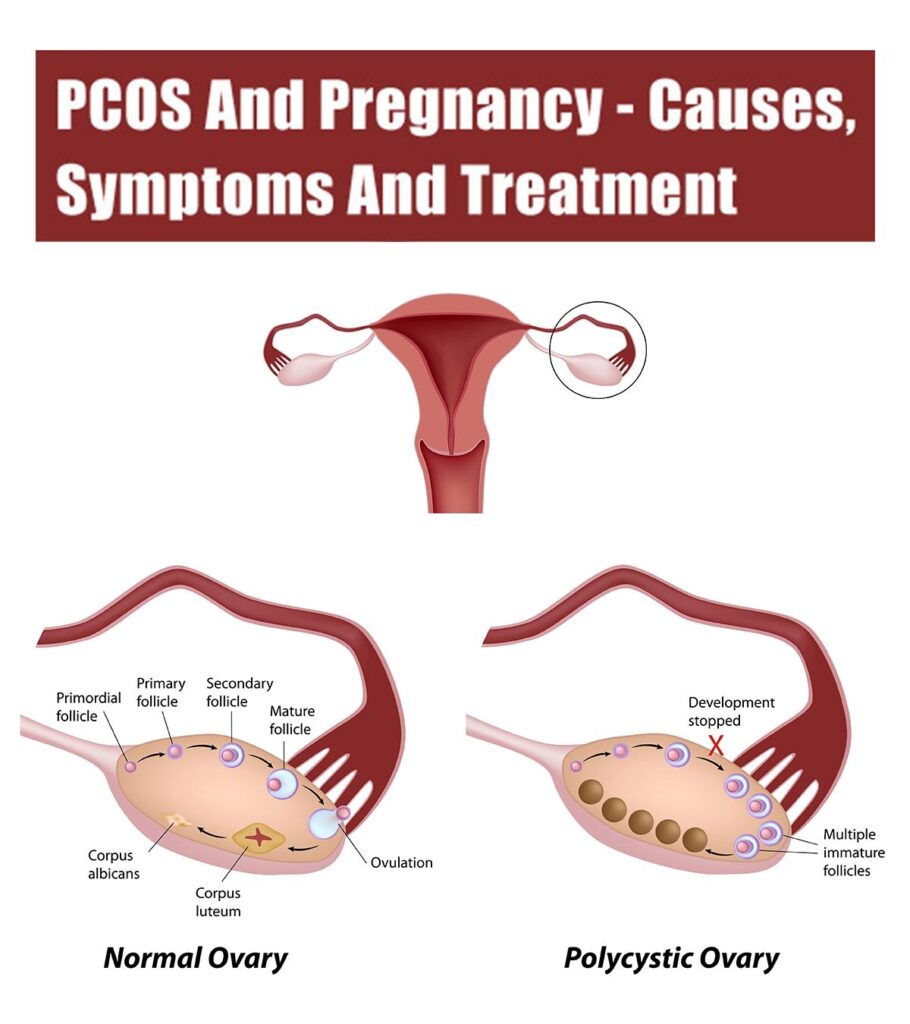
Management of PCOS early-on will definitely be advantageous in women seeking to conceive. PCOS is the most common cause of anovulatory infertility; ∼ 90–95% of anovulatory women seeking treatment for infertility have PCOS. Women may learn they have PCOS only after seeking infertility treatment. Most women with PCOS have elevated levels of luteinizing hormone (LH) and reduced levels of follicle-stimulating hormone (FSH), coupled with elevated levels of androgens and insulin. These imbalances can manifest as oligomenorrhea or amenorrhea (infrequent or lack of menstruation). Underproduction of estrogen and overproduction of androgens (testosterone, dehydroepiandrosterone, and androstenedione) by the ovaries can result in a number of additional clinical features, including tiny cysts on the surface of the ovaries (polycysts) and hair and skin symptoms. Women with PCOS who become pregnant are at higher risk than those without PCOS of developing gestational diabetes mellitus or suffering a first-trimester spontaneous abortion.
If you have decided that you are ready to start a family, find out how to get pregnant and some of the lifestyle changes that might help you. You’ve probably spent your adult life so far trying to avoid getting pregnant, so planning a pregnancy is often a big change. A woman is fertile (able to get pregnant) for just a few days in each menstrual cycle after an egg is released from her ovary, but around 1 in 3 women get pregnant within a month, so it’s best to be prepared for pregnancy before you stop contraception. Consult a gynecologist or reproductive specialist (like obstetrician) for the next steps and do’s and don’t’s.
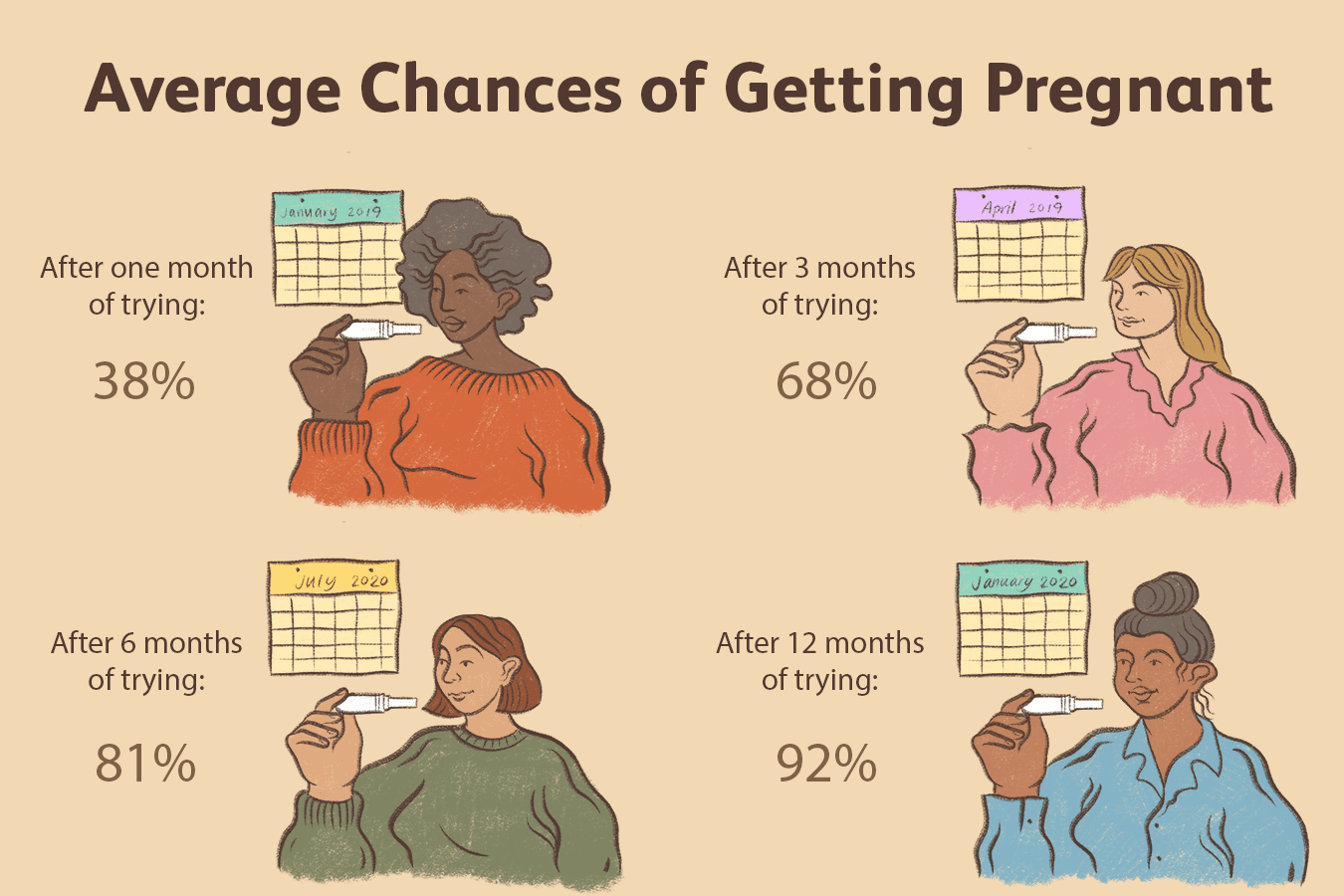
Women can still get pregnant with PCOS, although the complexity and probability will entirely depend on a case-by-case basis, owing to the prognosis, complications, and management modality of the individual. Although it is difficult to give statistics as cases vary so much and different treatments have different success rates, most women with PCOS will be able to have a baby with fertility treatment. For women who are under 35, this is even more the case.
In women with PCOS, the hormonal imbalance interferes with the growth and release of eggs from the ovaries (ovulation). If you don’t ovulate, you can’t get pregnant. If the woman is undergoing treatment to correct the hormonal imbalance and ovulation cycles, conceiving can be achieved. Birth control pills (also known as oral contraceptives) also help keep hormones in check if administered at the same time every day, without missing a dose. Although birth controls are used to avoid pregnancy, early management of PCOS can be done effectively with birth control to keep hormone levels and other hormonal pathways are controlled. One may consider understanding more and talking to a gynecologist or reproductive specialist (like an obstetrician) about using birth control pills for a while to curb hormones and later stopping the pills when deciding to have a family. Family planning is another branch of science that helps in achieving the goal of healthy reproduction with both the newborn’s and the mother’s health as a priority.

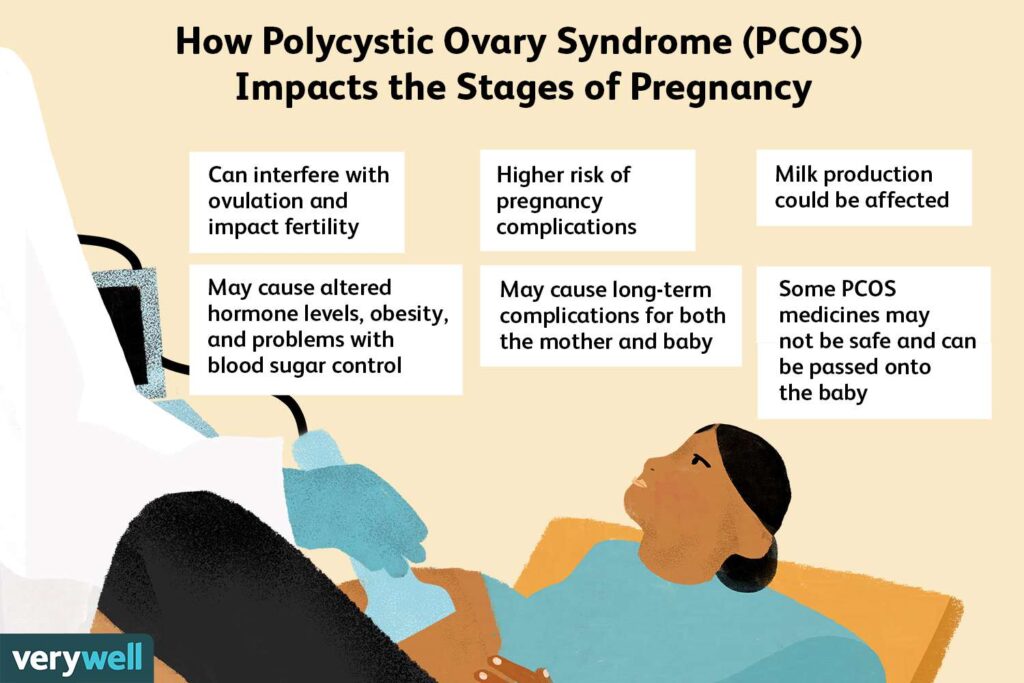
The first step in this process is to consult with a gynecologist or reproductive specialist (like an obstetrician). Every case or woman with PCOS is different, with respect to how far the hormones are imbalanced, what is the primary cause, and what is the management and treatment options. A specialist will run some tests to understand the exact cause, to suggest the tailored treatment.
Some treatment options (not limited to) for treatment of PCOS if you are trying to conceive:
There is no treatment for PCOS in itself but the symptoms can be treated. If you have a BMI of over 30, you will be advised to lose weight with healthy eating and exercise. This alone may get your body ovulating. Even if it does not do this, it will allow your medication to work better and will cut down on risks during pregnancy.
- There are a number of different medicines that help with conceiving with PCOS:
- Clomifene citrate (the best-known brand in the UK is Clomid) – stimulates your ovaries to release eggs
- metformin is used to correct insulin resistance, which may also be present with PCOS
- a combination of the above.
- If you are taking clomifene citrate tablets:
- you will have a transvaginal scan in the first cycle of treatment to check whether it is the correct dose for you. The scan will look at your follicles to see how they are developing.
- you will not be given it for more than six months as it increases your risk of ovarian cancer.
- If clomifene citrate doesn’t work then you may be offered:
- gonadotrophins (a fertility drug that is based on the gonadotrophin hormones, which stimulate your ovaries to produce and ripen eggs). These are more likely to overstimulate your ovaries and cause multiple pregnancies but you will have regular scans to check on developing follicles.
- surgery using a technique called laparoscopic ovarian drilling (LOD). This kills the tissue on the ovaries that produces the testosterone.
- IVF – in which the egg is retrieved, fertilized outside the body, and transferred into the uterus.
TIMING – Copulation/ Intercourse at the right time during peak ovulation can increase your chances of conceiving. A woman can only get pregnant during the ‘fertile window’ in the menstrual cycle. There are a few ways to work out when you’re ovulating. Your chance of getting pregnant is dramatically increased if you have sex on the day of ovulation, or two days before that. There are several Ovulation Calculators available as applications or websites to track the peak ovulation date to help with conception.
How does this work?:
Ovulation is when a mature egg is released from the ovary. The egg then moves down the fallopian tube where it can be fertilised. If sperm are in the fallopian tube when the egg is released, there is a good chance that the egg will be fertilised, creating an embryo, which can grow into a baby.
Pregnancy is technically only possible if you have sex during the five days before ovulation or on the day of ovulation. But the most fertile days are the three days leading up to and including ovulation. Having sex during this time gives you the best chance of getting pregnant.
By 12-24 hours after ovulation, a woman is no longer able to get pregnant during that menstrual cycle because the egg is no longer in the fallopian tube.
There’s almost no chance of getting pregnant if you have sex before or after the fertile window (but if you’re not trying to get pregnant, don’t rely on this – contraception is your best option!).
AGE – A woman’s age is the most important factor affecting her fertility and her chance of having a baby. The chance of having a child is much higher for women younger than 35 years and men younger than 40 years than for older women and men.
How does this work?:
It’s a biological fact that as women and men age, their potential to have children decreases, although the exact time when this starts to happen can vary among individuals. We all know someone who had a healthy baby in their late 30s or early 40s. But of all people who try for a baby at a later age, many will not have the baby they hoped to have.
Across a population, women younger than 35 and men younger than 40 have a better chance of having a child than people who are older. This is true for natural pregnancies and for pregnancies conceived through assisted reproductive treatments such as IVF (in-vitro fertilization).
DRUGS AND CHEMICALS – Making some healthy lifestyle changes can increase your chance of becoming pregnant and having a healthy baby.
How does this work?:
- Smoking – There is no safe limit for smoking, the only way to protect yourself and your unborn baby from harm is to quit. People who smoke are more likely to have fertility problems and take longer to conceive than non-smokers. The chemicals in cigarettes damage eggs and sperm, and can affect a baby’s health.
- Caffeine – Coffee and various types of tea contain caffeine, and energy drinks and some soft drinks have a high caffeine content. Although it’s not clear whether caffeine affects the chance of pregnancy, but experts advise limiting caffeine if you’re trying to conceive and during pregnancy. Some studies have found that women who drink large amounts of caffeine may take longer to become pregnant and have a slightly higher risk of miscarriage and low birth weight.
- Alcohol – Heavy drinking increases the time it takes to get pregnant and can affect a developing baby’s health. Heavy drinking can reduce men’s sex drive, affect the quality of sperm and cause impotence. For women planning a pregnancy, not drinking alcohol is the safest option.
- Recreational Drugs – Recreational drugs reduce the chance of pregnancy and having a healthy baby. Using cannabis can lower men’s sperm count. Long-term use of cocaine, heroin and ecstasy can lead to permanent reproductive problems for people of all genders.
- Chemicals in our environment – Some chemicals can affect reproductive health and reduce the chance of getting pregnant. It’s difficult to completely avoid chemicals in our environment, however there are some simple ways to reduce your exposure. Studies show that endocrine disrupting chemicals (EDCs) can reduce the quality of sperm and eggs and affect a person’s chance of becoming pregnant. Around 95 per cent of people have EDCs in their bodies and that people who struggle to conceive have higher levels of some EDCs. Avoiding these chemicals may increase the chance of having a baby.
- Lubricants – When trying for a baby, intercourse can become a mission rather than a pleasure. Having intercourse during the ‘fertile window’ gives you the best chance of getting pregnant. Some couples can use lubricants during intercourse. Choosing one that’s been shown in studies to be safe and sperm-friendly is important, because some types can affect the sperm’s quality. These are usually labelled ‘fertility friendly’ lubricants and can be safely used when trying to conceive. Some natural oils – including olive, canola, mustard, and baby oils – are also considered sperm-friendly lubricants and can be used for safe copulation during the fertility window.
HEALTH AND MEDICAL – Health and medical conditions, not only PCOS, may also affect the chances of conception.
How does this work?:
- Conditions and Diseases – Diabetes, PCOS, cancer, endometriosis, early menopause, premature ovarian insufficiency, sexually transmitted diseases, etc., can affect the chances of pregnancy.
- Medications – While some medications are safe to use before and during pregnancy, others can affect your chances of getting pregnant. If you are taking medication, it is important to get advice from your doctor about the safety of the medication before you start trying for a baby. Decisions to continue or stop medications need to take into account the underlying medical condition being treated. There are specialist health services that can provide up-to-date information on medications and fertility.
- Healthy Sperm – Did you know there are ways that men can keep their sperm healthy? Healthy sperm have a better chance of creating a pregnancy. Keep your testes cool if you want to be a father in the future. About half the cases of infertility are due to problems with the man’s reproductive system. It takes about three months for men to make new sperm. So it’s really important to be as healthy as possible in the three months leading up to conception.
- Oral Health – During pregnancy, a woman’s oral health can affect her health and the health of the baby. If you are trying for a baby it’s a good idea to have a check-up with your dentist. Infections and inflammation in the mouth have been linked to an increased risk of developing preeclampsia, premature birth, and having a baby with a lower than normal birth weight. Gum disease affects most people at some time during their life. Gingivitis is the early stage of gum disease and is caused by a build-up of plaque between the tooth and the gum. Bleeding when brushing teeth or swelling of the gum can be signs of gingivitis. If it’s not treated, gingivitis can lead to an advanced form of gum disease called periodontitis. This is when a pocket forms between the tooth and the gum where bacteria can grow and cause inflammation. If you are trying for a baby it’s a good idea to have a check-up with your dentist to make sure you don’t have signs of gum disease. And, if there are signs of gum disease, your dentist can advise you about the best way to treat it. Here are some tips for avoiding gum disease:
- Eat a healthy and balanced diet of fresh fruit and vegetables, lean meat, fish and whole grains
- Avoid saturated fats in your diet
- Avoid sugary foods and drinks, or limit them to meal times
- Brush your teeth and gums twice a day with fluoridated toothpaste
- Visit a dentist or other oral health professional regularly
- Drink plenty of fluoridated tap water
- Avoid smoking.
HEALTHY EATING AND EXERCISE – If you’re planning a pregnancy, healthy eating and regular exercise can boost your fertility.
How does this work?:
A healthy diet and regular exercise can improve both male and female fertility. A healthy weight increases your chance of a healthy pregnancy and a healthy baby. Eating a healthy, balanced diet and exercising regularly are two of the best things you can do to improve your overall health and fertility. Both habits contribute to a healthy weight, which increases your chance of a pregnancy and a healthy baby. Women planning a pregnancy should also supplement their diet with folate and iodine–micronutrients that reduce the risk of birth defects such as spina bifida and cleft palate.
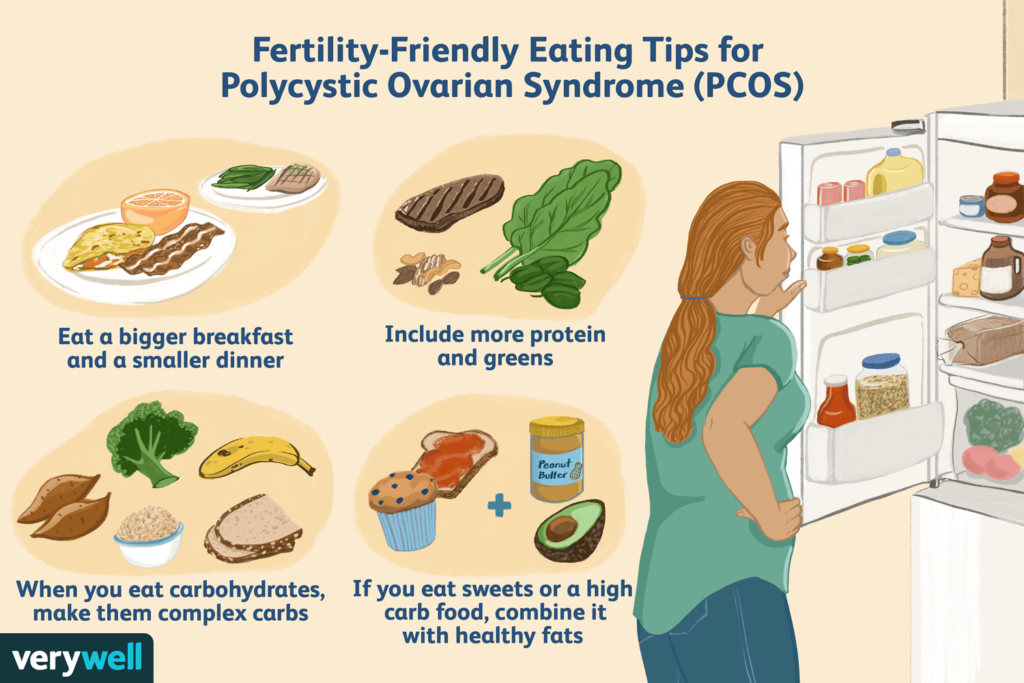
If you’re not in the healthy weight range, you’re not alone. Most of us carry more weight than our parents and grandparents did when they were our age. Being underweight or overweight can reduce your chance of a pregnancy. If you’re overweight, losing even a few kilos can improve your fertility. A man’s weight also affects the couple’s ability to have a baby. On average, men who are overweight or obese are not as fertile as men who are in a healthy weight range. One way to measure whether you’re in a healthy weight range is using the Body Mass Index or BMI. You can enter your height and weight into this BMI calculator to find out your BMI number.
A BMI between 18.5 and 24.9 is considered a ‘healthy weight’
A BMI below 18.5 is considered ‘underweight’
A BMI between 25 and 29.9 is considered ‘overweight’
A BMI over 30 is considered ‘obese’
Most women with PCOS are aware that they may have some difficulty becoming pregnant. However many women aren’t aware that having PCOS can also increase their risk for certain pregnancy-related complications. Even after conception, PCOS, as a condition, makes it harder on the pregnancy. Listed below are some of the most common complications associated with PCOS:
MISCARRIAGE:
If you haven’t been diagnosed with PCOS but have had a miscarriage or multiple miscarriages, you should be evaluated for PCOS, as one study found that PCOS was present in approximately 40% to 80% of women with recurrent miscarriages.
Source: Verywellhealth website
Women who have PCOS do appear to be at a slightly higher risk for having a miscarriage, though the cause for this relationship is unclear. Researchers believe that a few factors may be to blame.
First, women with PCOS tend to have longer menstrual cycles, meaning that ovulation occurs later on. This exposes the developing egg to lots of hormones, possibly damaging it.
Second, there is a known relationship between uncontrolled blood sugar and miscarriage. Given that women with PCOS tend to have insulin resistance and elevated insulin levels, some researchers hypothesize that this may contribute to poor egg quality and miscarriage.
High androgen levels and endometrial dysfunction, meaning problems with implantation, may also play a role in the increased risk of early pregnancy loss in women with PCOS. That said, more research is needed before a clear association can be developed.
GESTATIONAL HYPERTENSION AND PREECLAMPSIA:
Gestational hypertension refers to women who develop new-onset high blood pressure after 20 weeks. Preeclampsia is a serious health condition that also develops in the second half of pregnancy and causes protein in the urine, in addition to high blood pressure.
If left untreated, preeclampsia can progress to the severe form of the syndrome called eclampsia, which can cause seizures, blindness, and/or coma. In serious cases, both maternal and fetal death can result.
Every time you visit your healthcare provider, they will check your blood pressure and sometimes take a urine sample to look for protein in the urine. This is to make sure that you are not developing preeclampsia.
If you are diagnosed with preeclampsia, treatment may involve bed rest, frequent monitoring, and sometimes medication to lower your blood pressure. If your symptoms get worse, the only known cure is to deliver the baby. The goal is to get the baby as far along in the pregnancy as possible so that the lungs have a chance to develop.
Women with PCOS may be at greater risk for high blood pressure. If it’s determined that you are at high risk, your healthcare provider may recommend low-dose aspirin (81 milligrams/day)—starting at 12 weeks of pregnancy—to help prevent preeclampsia and its related complications.
It’s also important to watch out for signs and symptoms of gestational hypertension and preeclampsia (swelling, rapid weight gain, severe headache, vision changes) and promptly report them to your healthcare provider, or proceed to the emergency room if necessary.
GESTATIONAL DIABETES:

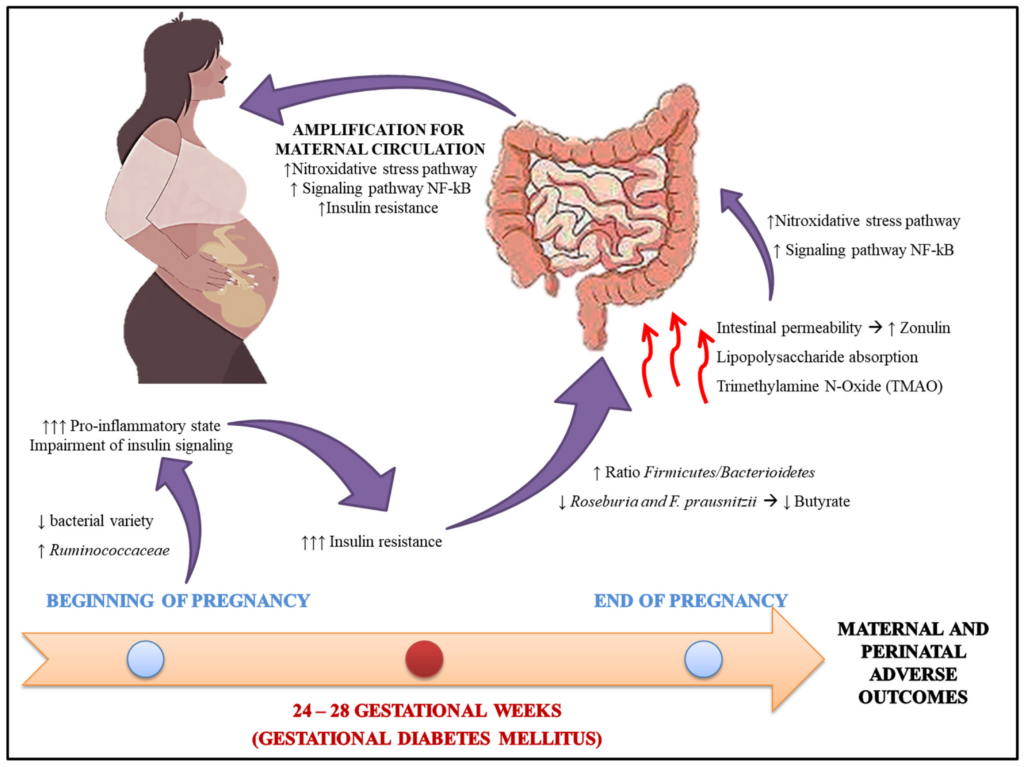
Gestational diabetes occurs when diabetes, an alteration in how the body processes sugar, develops during pregnancy. While the condition usually resolves after giving birth, a woman with gestational diabetes is more likely to develop type 2 diabetes later in life, requiring ongoing monitoring of blood sugar levels.
All pregnant women are monitored for gestational diabetes with routine blood sugar screening sometime between 26 and 28 weeks. Women with known diabetes, insulin resistance, or who are at higher risk for developing gestational diabetes may be screened earlier.
Women who are older than 25, have had gestational diabetes with prior pregnancies, who are overweight, who have prediabetes, or who have close family members who have been diagnosed with type 2 diabetes are at greater risk for developing gestational diabetes. Women with PCOS are a part of that group because of the association with insulin resistance and prediabetes.
Gestational diabetes can be treated with a combination of lifestyle changes or medication if necessary. It’s important to be vigilant about monitoring your blood sugar as directed by your healthcare provider because babies born to mothers with gestational diabetes are at higher risk for high birth weight, preterm birth, respiratory issues at birth, low blood sugar, and jaundice.
PREMATURE DELIVERY:
Women with PCOS are also at risk of delivering their babies early. The reason behind this again is not totally clear. Experts do know that preeclampsia is a risk factor for premature delivery, and women with PCOS are at a higher risk of preeclampsia.
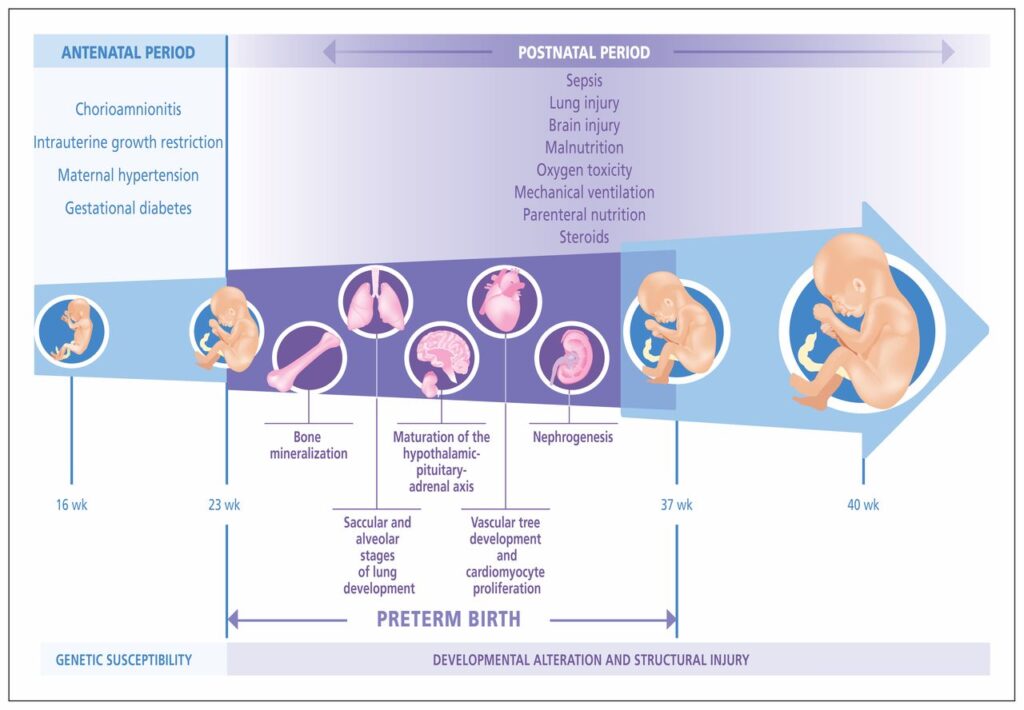
Source: Preterm birth: risk factor for early-onset chronic diseases; CMAJ article
In addition, experts have found that babies born to moms with PCOS are more likely to be large (called large for gestational age), have meconium aspiration (when a baby’s first stool gets into their lungs), and have a low Apgar score (a test given to newborns soon after birth. This test checks a baby’s heart rate, muscle tone, and other signs to see if extra medical care or emergency care is needed) at five minutes.
